杏(Prunus armeniaca L.)是 蔷 薇 科 杏 属 植物[1]。新疆作为野生杏的起源中心之一,拥有丰富多样的杏种质资源[2]。野生杏主要分布在天山山脉以北的伊犁河谷,野生杏中蕴含着十分丰富且优良的性状基因,具有丰富的表型多样性及遗传多样性[3-5]。2000多年前,杏仁就被用来制作成食品以供人类食用[6]。杏仁的营养价值高,药用效果好[7-9]。随着科技进步,人们生活水平不断提高,发现杏仁还有润肺止咳、降血糖、抗肿瘤等诸多作用[10-11]。
矿质元素对人体的新陈代谢产生至关重要的作用,是维持人体健康必不可少的营养物质[12]。摄入量过多或者缺少都会在不同程度上引发人体的相关疾病[13]。由此可见矿质元素在维持人体部分重要生理功能中起到了极其重要的作用。研究发现,不同产区、不同品种杏果实中的营养物质含量存在不同程度的差异[14-15]。
氨基酸是生命活动的基础物质,氨基酸可以转变为脂肪和碳水化合物、合成组织蛋白或多种激素、抗体,在人体代谢中具有重要的生理功能,由于人体有一部分氨基酸不能在体内合成,必须从食物中摄取,此部分氨基酸被称为必需氨基酸。研究杏仁氨基酸组分的相关方法已经有了一定基础,史清华等[16]对苦杏仁氨基酸进行了分析和评价,认为苦杏仁中氨基酸种类齐全、必需氨基酸含量高。李翠芹等[17]对甜杏仁的微量元素及氨基酸进行了测定,认为杏仁在富含微量元素及氨基酸的基础上,具有较高的食用价值和保健作用,是有利于人体氨基酸营养平衡的优质果仁资源,具有良好的发展前景,可以深入研究。
目前已经针对新疆野生杏的种群结构特征[4]、不同坡向适应性[18]以及野杏果实和种子性状与海拔之间存在的相关性[19]等方面进行研究。至今对野生杏种仁矿质营养与氨基酸的分析尚不清楚,这限制了野生杏资源的评价和利用。笔者在本研究中以30 份野生杏种仁为试验材料,测定8 种矿质元素含量和17种氨基酸含量,并对其变异程度、相关性、主成分进行综合评价,旨在发现各指标含量的差异,进一步探究野生杏仁矿质元素及氨基酸含量之间的关系,为深入挖掘新疆野生杏种质的优异资源、培育更多优良品质的仁用杏提供数据支撑和依据。
1 材料和方法
1.1 材料
1.1.1 试验地概况 供试材料取自新疆维吾尔自治区新源县的吐尔根乡杏花沟,该地区属于温带大陆半干旱气候。地理范围E 83°25′52′~83°26′56′,N 43°32′17′~43°32′44′,海拔在1 064.76~1 177.40 m 之间。区域内的野生杏为纯林,每棵实生株之间的距离大于100 m。在采样的过程中,选择树龄、树势均相近的实生株,且均在杏花沟的同一坡面上。黑钙土作为主要的土壤类型,分布均匀,腐殖层深厚[19-20]。
1.1.2 试验材料及前处理 样本采集时间为果实完全成熟时期。在每株树的树冠外围,从北、南、西、东4 个方向依次采30 个成熟果实,共120 个果实。将采集完毕的果实带回实验室,随即剔除果肉,将所有的杏核按株进行分批标记,放置在通风处,使其自然风干。待杏核完全晾干后,破核取仁,分批放在-20 ℃的冰箱内,待之后处理。试验材料详细定位见表1。
表1 野生杏种质地理位置信息
Table 1 Geographic information of wild apricot germplasm
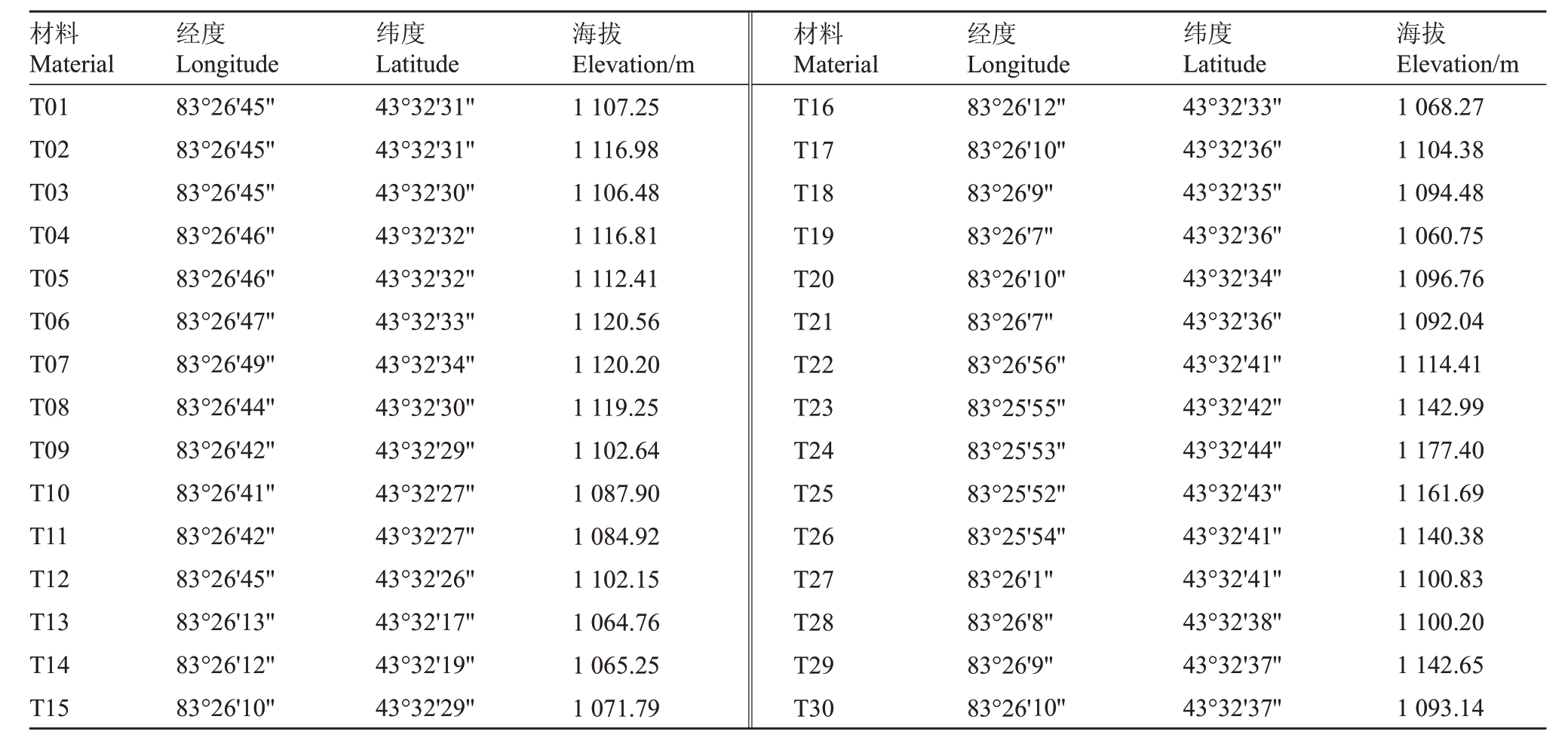
材料Material T01 T02 T03 T04 T05 T06 T07 T08 T09 T10 T11 T12 T13 T14 T15经度Longitude 83°26′45′′83°26′45′′83°26′45′′83°26′46′′83°26′46′′83°26′47′′83°26′49′′83°26′44′′83°26′42′′83°26′41′′83°26′42′′83°26′45′′83°26′13′′83°26′12′′83°26′10′′纬度Latitude 43°32′31′′43°32′31′′43°32′30′′43°32′32′′43°32′32′′43°32′33′′43°32′34′′43°32′30′′43°32′29′′43°32′27′′43°32′27′′43°32′26′′43°32′17′′43°32′19′′43°32′29′′海拔Elevation/m 1 107.25 1 116.98 1 106.48 1 116.81 1 112.41 1 120.56 1 120.20 1 119.25 1 102.64 1 087.90 1 084.92 1 102.15 1 064.76 1 065.25 1 071.79材料Material T16 T17 T18 T19 T20 T21 T22 T23 T24 T25 T26 T27 T28 T29 T30经度Longitude 83°26′12′′83°26′10′′83°26′9′′83°26′7′′83°26′10′′83°26′7′′83°26′56′′83°25′55′′83°25′53′′83°25′52′′83°25′54′′83°26′1′′83°26′8′′83°26′9′′83°26′10′′纬度Latitude 43°32′33′′43°32′36′′43°32′35′′43°32′36′′43°32′34′′43°32′36′′43°32′41′′43°32′42′′43°32′44′′43°32′43′′43°32′41′′43°32′41′′43°32′38′′43°32′37′′43°32′37′′海拔Elevation/m 1 068.27 1 104.38 1 094.48 1 060.75 1 096.76 1 092.04 1 114.41 1 142.99 1 177.40 1 161.69 1 140.38 1 100.83 1 100.20 1 142.65 1 093.14
1.2 试验方法
1.2.1 矿质元素含量测定 钾、钠元素含量参照GB5009.91—2017《食品中钾、钠的测定》的火焰原子发射光谱法测定;钙元素含量参照GB5009.92—2016《食品中钙的测定》测定;镁元素含量参照GB5009.241—2017《食品中镁的测定》测定;锌元素含量参照GB5009.14—2017《食品中锌的测定》测定;铁元素含量参照GB5009.90—2016《食品中铁的测定》测定;铜元素含量参照GB5009.13—2017《食品中铜的测定》测定;锰元素含量参照GB5009.242—2017《食品中锰的测定》测定。钙、镁、锌、铁、铜和锰6 种元素采用火焰原子吸收光谱法测定。
1.2.2 氨基酸含量测定 测定方法与黄雪等[21]的方法一致,所检测的氨基酸包括天冬氨酸(Asp)、苏氨酸(Thr)、色氨酸(Ser)、谷氨酸(Glu)、甘氨酸(Gly)、丙氨酸(Ala)、缬氨酸(Val)、甲硫氨酸(Met)、半胱氨酸(Cys)、异亮氨酸(Ⅰle)、亮氨酸(Leu)、酪氨酸(Tyr)、苯丙氨酸(Phe)、组氨酸(His)、赖氨酸(Lys)、精氨酸(Arg)、脯氨酸(Pro)共17种。
参照氨基酸比值系数法,根据联合国粮农组织(Food and Agriculture Organization,FAO)/世界卫生组织(World Health Organization,WHO)1973年修正的理想蛋白人体必需氨基酸模式谱,评价伊犁野生杏种仁氨基酸的营养价值。具体指标包括:氨基酸比值(amino acid ratio,RAA)、氨基酸比值系数(amino acid ratio coefficient,RCAA)、氨基酸比值系数分(amino acid ratio coefficient score,SRCAA)。分别按照公式(1)~(3)计算。由于酪氨酸由苯丙氨酸转变而来,半胱氨酸由甲硫氨酸转变而来,因此将酪氨酸+苯丙氨酸,半胱氨酸+甲硫氨酸分别合并计算。

1.3 数据分析
使用Excel 对数据进行整理,使用Origin 2021进行各指标含量及相关性作图,使用ⅠBM SPSS Statistics 26.0进行主成分及综合分析。
2 结果与分析
2.1 野生杏种仁矿质元素的组成
由图1、图2可知,在所测定的30份不同种质杏仁中均检测出了4种大量元素(钾、钙、钠、镁)和4种微量元素(锌、铁、铜、锰)。在测定结果中,T14 的钾、镁、锰含量最高,T01的钾含量最低;T13的钙、铁含量最高,但镁的含量最低;T03的钙含量最低,T04的铁含量最低;T26的钠、锌含量最高,T02的钠含量最低;T29的锌含量最低;T19的铜含量最高,T10的铜含量最低;T30 的锰含量最低;矿质元素总含量(w,后同)以种质T14 最高,为10 590.93 mg·kg-1;T13 最低,为6 755.09 mg·kg-1。
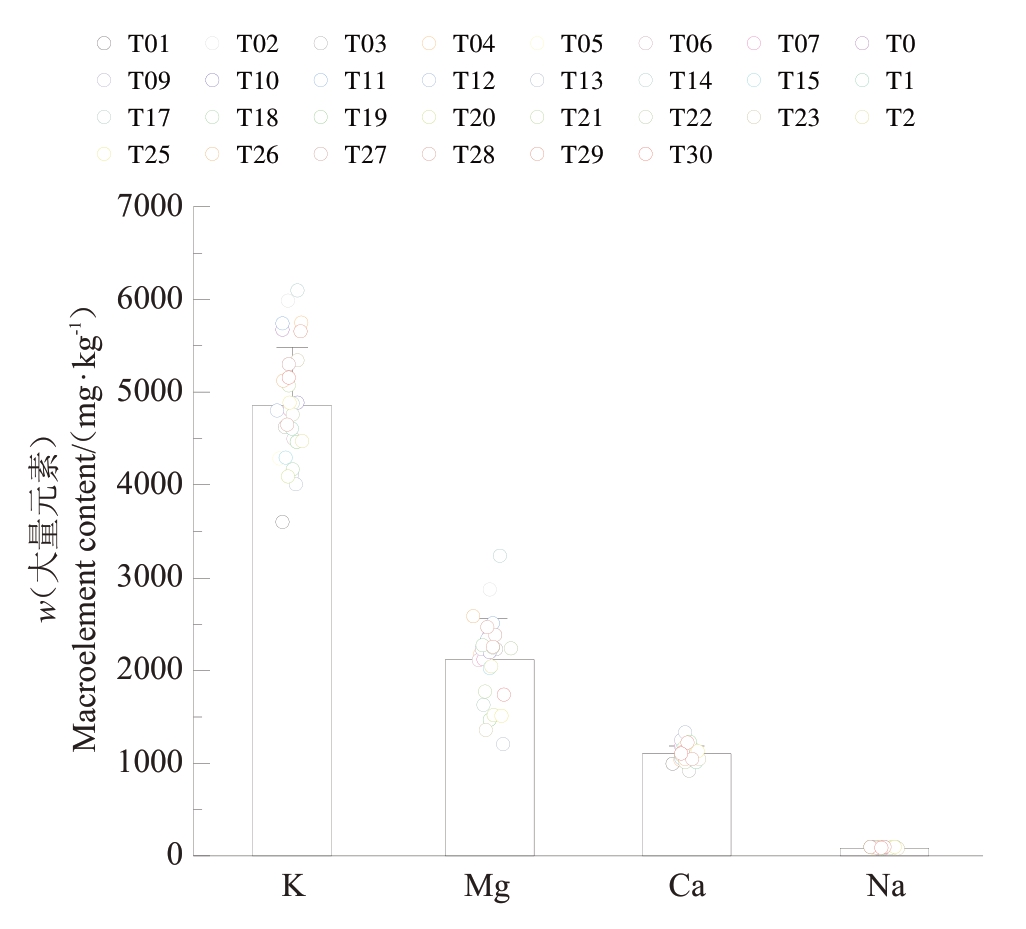
图1 野生杏种仁大量元素含量
Fig.1 Contents of elements in wild apricot kernels
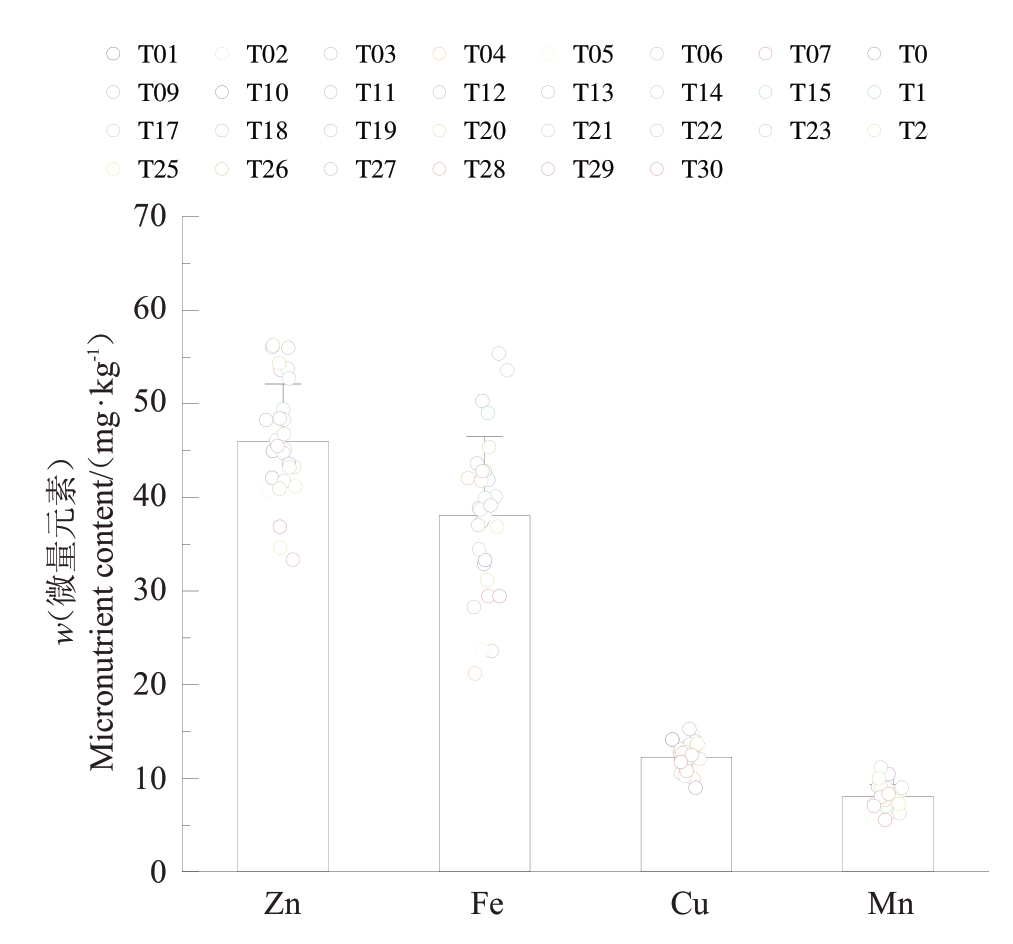
图2 野生杏种仁微量元素含量
Fig.2 Micronutrient contents of wild apricot kernels
由表2 可得,在所测定的以下8 种矿质元素中,大量元素平均含量依次为钾>镁>钙>钠,且4 种元素含量差异较大。微量元素各平均含量高低依次为锌>铁>铜>锰。在供试30 个种质杏仁的矿质元素含量中,铁的变异系数最大,为22.12%;钙的变异系数最低(7.78%),钠的变异系数为8.39%,二者属于弱变异,除此以外其他元素含量均超过10%,属于中等变异强度。
表2 野生杏种仁矿质元素含量分析
Table 2 Comparison of mineral elements content in wild apricot kernels

注:变异系数≤10%为弱变异,10%<变异系数<100%为中等变异,变异系数≥100%为强变异。下同。
Note:Coefficient of variation ≤10%is weak variation,10%<coefficient of variation<100% is moderate variation, coefficient of variation ≥100%is strong variation.The same below.
元素Element钾K钙Ca钠Na镁Mg锌Zn铁Fe铜Cu锰Mn总含量Total content均值Average/(mg·kg-1)4 856.98 1 097.22 86.36 2 115.01 45.97 38.05 12.22 8.00 8 259.81最大值Maximum/(mg·kg-1)6 091.52 1 326.74 95.17 3 235.59 56.24 55.36 15.24 11.11 10 590.93最小值Minimum/(mg·kg-1)3 595.67 917.94 72.38 1 204.00 33.33 21.16 8.95 5.50 6 755.09标准差SD 630.29 85.35 7.25 443.55 6.14 8.42 1.45 1.29 896.66变异系数CV/%12.98 7.78 8.39 20.97 13.37 22.12 11.90 16.07 10.86
2.2 野生杏仁氨基酸含量差异分析
结合图3、图4 和表3,在所选30 份新疆伊犁野生杏种仁中,以下17 种氨基酸均有被检测出,平均含量最高的是谷氨酸(6.62%),组氨酸最低(0.03%)。且17 种氨基酸含量的变异系数介于18.37%(甲硫氨酸)~50.16%(半胱氨酸)之间,变异较为丰富。其中甲硫氨酸含量为0.17%~0.33%,半胱氨酸含量为0.07%~0.45%。
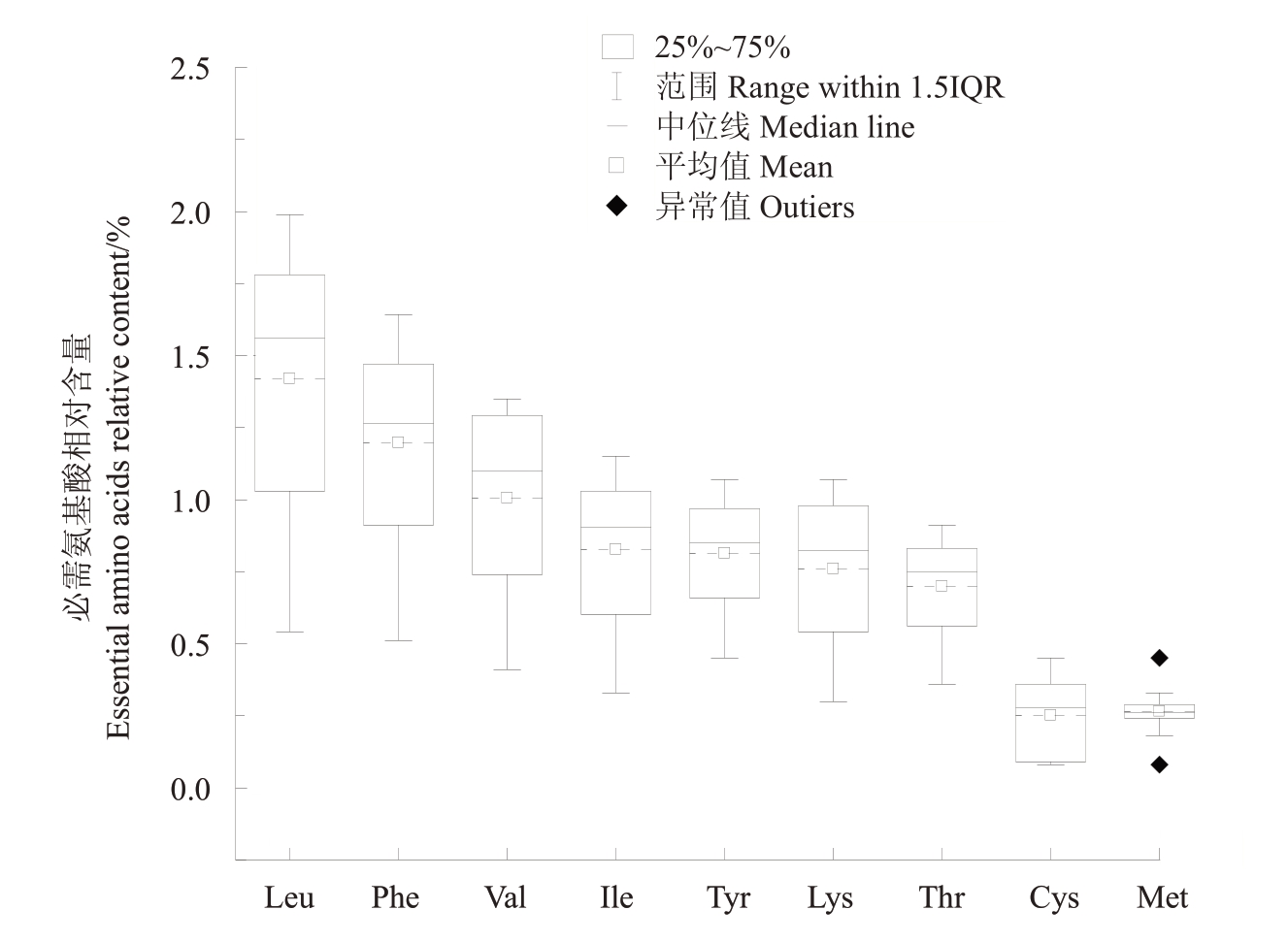
图3 野生杏种仁必需氨基酸含量变化范围
Fig.3 Variation range of essential amino acid content in wild apricot kernels
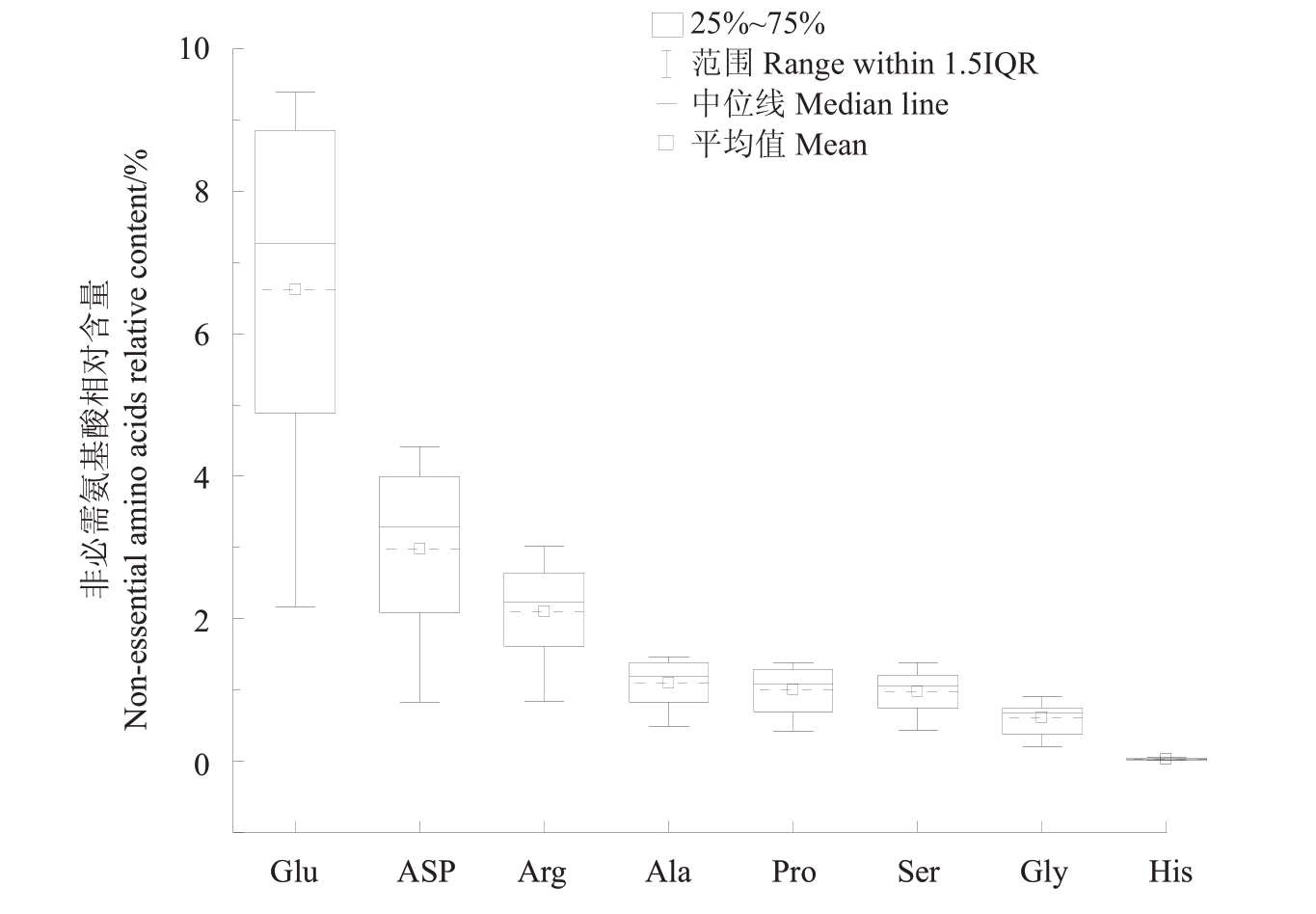
图4 野生杏种仁非必需氨基酸含量变化范围
Fig.4 Variation range of non-essential amino acid content in wild apricot kernels
表3 野生杏仁氨基酸组成与含量分析
Table 3 Analysis of amino acid composition and content of wild apricot kernels

氨基酸Amino acid必需氨基酸EAA非必需氨基酸NEAA总氨基酸TAA苦味氨基酸BAA甜味氨基酸SAA药用氨基酸MEA必需氨基酸/总氨基酸EAA/TAA必需氨基酸/非必需氨基酸EAA/NEAA均值Average/%7.21 15.41 22.62 6.83 4.39 16.74 32.47 48.22最大值Maximum/%9.66 21.51 31.16 9.44 6.03 23.31 37.92 61.09最小值Minimum/%3.29 5.38 8.67 2.83 1.90 6.00 30.11 43.07变异系数CV/%28.66 34.25 32.43 29.82 29.32 33.61 6.46 9.93
必需氨基酸(essential amino acids,EAA)的含量在3.29%~9.66%之间,非必需氨基酸(nonessential amino acids,NEAA)的含量在5.38%~21.51%之间,总氨基酸(total amino acids,TAA)含量在8.67%~31.16%之间。必需氨基酸/总氨基酸(EAA/TAA)在30.11%~37.92%之间。必需氨基酸/非必需氨基酸(EAA/NEAA)在43.07%~61.09%之间,发现T21、T24、T25、T29、T30最接近FAO/WHO提出的理想蛋白模式(EAA/TAA≥40%,EAA/NEAA≥60%)。
30份野生杏仁中苦味氨基酸(bitter amino acid,BAA)包括组氨酸、天冬氨酸、缬氨酸、甲硫氨酸、亮氨酸、异亮氨酸、苯丙氨酸,含量范围为2.83%~9.44%;甜味氨基酸(sweet amino acid,SAA)包括色氨酸、甘氨酸、丙氨酸、苏氨酸、脯氨酸,含量范围为1.90%~6.03%;药用氨基酸(medicinal amino acid,MEA)包括天冬氨酸、谷氨酸、甘氨酸、精氨酸、酪氨酸、甲硫氨酸、赖氨酸、亮氨酸、苯丙氨酸,含量范围为6.00%~23.31%。MEA 的含量相对于BAA、SAA较高,不同种质杏种仁的氨基酸含量有一定程度的差异,平均变异系数达33.61%,MEA 含量在总氨基酸含量中的占比为69.23%~75.61%。其中T01 的BAA 和MEA 含量最高,T07 的SAA 含量最高;T24的3种氨基酸含量均为最低。
必需氨基酸的组成比例与FAO/WHO模式值越接近,表明越符合人体需求,营养价值就越高。对比不同野生杏种质杏仁的必需氨基酸比例(表4),可以看出苯丙氨酸+酪氨酸的平均比值高于模式值1.5倍。
表4 野生杏仁必需氨基酸组成与FAO/WHO 建议值的对比
Table 4 Comparison of essential amino acid composition of wild apricot kernels with FAO/WHO recommended value
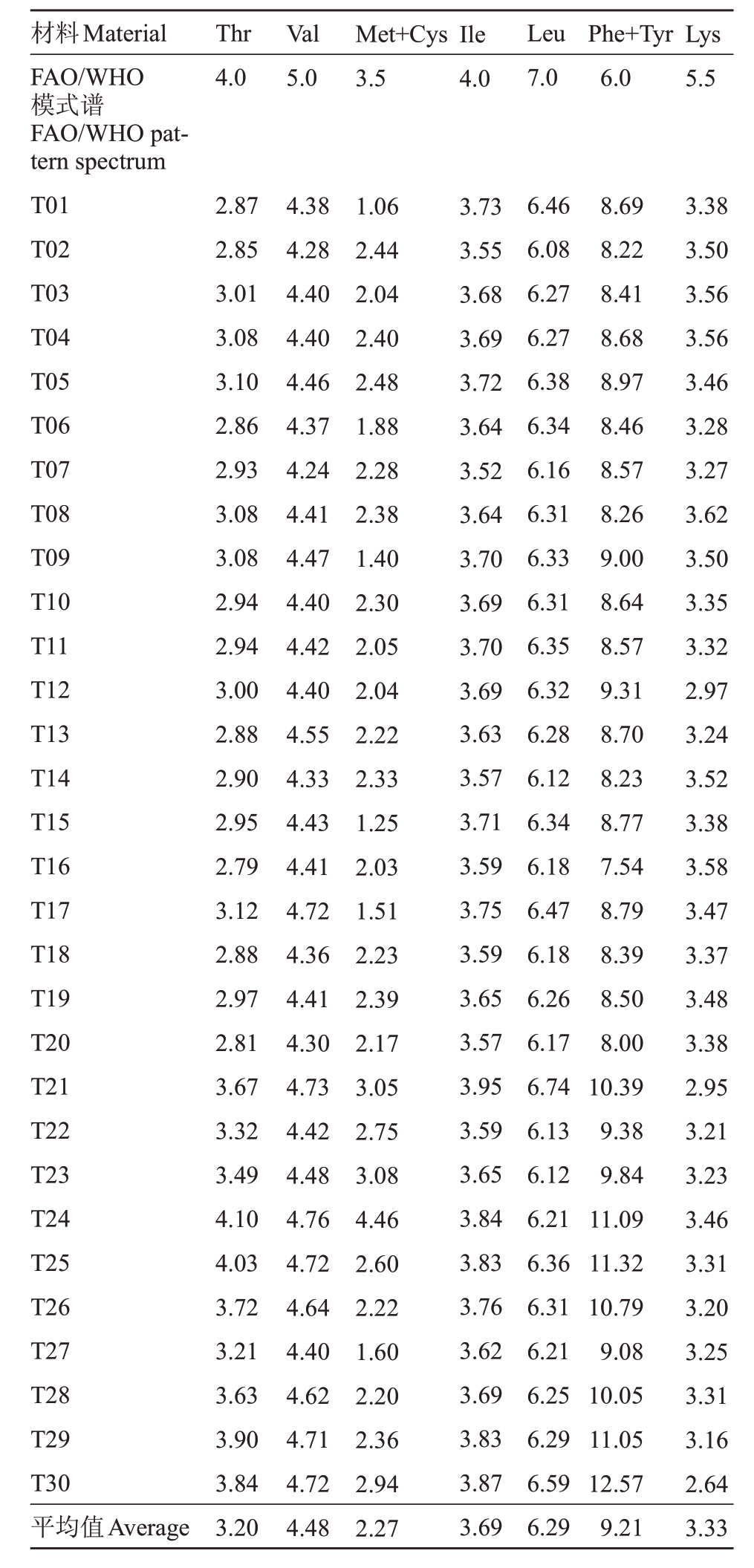
材料Material FAO/WHO模式谱FAO/WHO pattern spectrum T01 T02 T03 T04 T05 T06 T07 T08 T09 T10 T11 T12 T13 T14 T15 T16 T17 T18 T19 T20 T21 T22 T23 T24 T25 T26 T27 T28 T29 T30平均值Average Thr 4.0 Val 5.0 Met+Cys 3.5Ⅰle 4.0 Leu 7.0 Phe+Tyr 6.0 Lys 5.5 2.87 2.85 3.01 3.08 3.10 2.86 2.93 3.08 3.08 2.94 2.94 3.00 2.88 2.90 2.95 2.79 3.12 2.88 2.97 2.81 3.67 3.32 3.49 4.10 4.03 3.72 3.21 3.63 3.90 3.84 3.20 4.38 4.28 4.40 4.40 4.46 4.37 4.24 4.41 4.47 4.40 4.42 4.40 4.55 4.33 4.43 4.41 4.72 4.36 4.41 4.30 4.73 4.42 4.48 4.76 4.72 4.64 4.40 4.62 4.71 4.72 4.48 1.06 2.44 2.04 2.40 2.48 1.88 2.28 2.38 1.40 2.30 2.05 2.04 2.22 2.33 1.25 2.03 1.51 2.23 2.39 2.17 3.05 2.75 3.08 4.46 2.60 2.22 1.60 2.20 2.36 2.94 2.27 3.73 3.55 3.68 3.69 3.72 3.64 3.52 3.64 3.70 3.69 3.70 3.69 3.63 3.57 3.71 3.59 3.75 3.59 3.65 3.57 3.95 3.59 3.65 3.84 3.83 3.76 3.62 3.69 3.83 3.87 3.69 6.46 6.08 6.27 6.27 6.38 6.34 6.16 6.31 6.33 6.31 6.35 6.32 6.28 6.12 6.34 6.18 6.47 6.18 6.26 6.17 6.74 6.13 6.12 6.21 6.36 6.31 6.21 6.25 6.29 6.59 6.29 8.69 8.22 8.41 8.68 8.97 8.46 8.57 8.26 9.00 8.64 8.57 9.31 8.70 8.23 8.77 7.54 8.79 8.39 8.50 8.00 10.39 9.38 9.84 11.09 11.32 10.79 9.08 10.05 11.05 12.57 9.21 3.38 3.50 3.56 3.56 3.46 3.28 3.27 3.62 3.50 3.35 3.32 2.97 3.24 3.52 3.38 3.58 3.47 3.37 3.48 3.38 2.95 3.21 3.23 3.46 3.31 3.20 3.25 3.31 3.16 2.64 3.33
参考氨基酸比值系数法,计算RAA、RCAA、SRCAA 值,以进一步评价野生杏仁的营养价值。RAA 和RCAA 值越接近1,表示食物中所含的必需氨基酸组成比例越接近标准模式值。RAA 和RCAA值分别在0.30~2.10和0.37~2.03之间,RCAA最小值对应的氨基酸为第一限制性氨基酸,结合表5可知,甲硫氨酸+半胱氨酸为第一限制性氨基酸的占比为30%,赖氨酸为第一限制性氨基酸的占比为70%。SRCAA表示氨基酸平衡的贡献大小,其范围在51.59(T30)~73.04(T16)之间。SRCAA 值前6 位的种质从高到低的排序分别是:T16(73.04)、T08(72.63)、T02(71.57)、T14(71.30)、T20(70.71)、T19(70.38)。
表5 野生杏仁中必需氨基酸的RAA、RCAA、SRCAA 计算结果
Table 5 Calculation results of RAA,RCAA and SRCAA of essential amino acids in wild apricot kernels
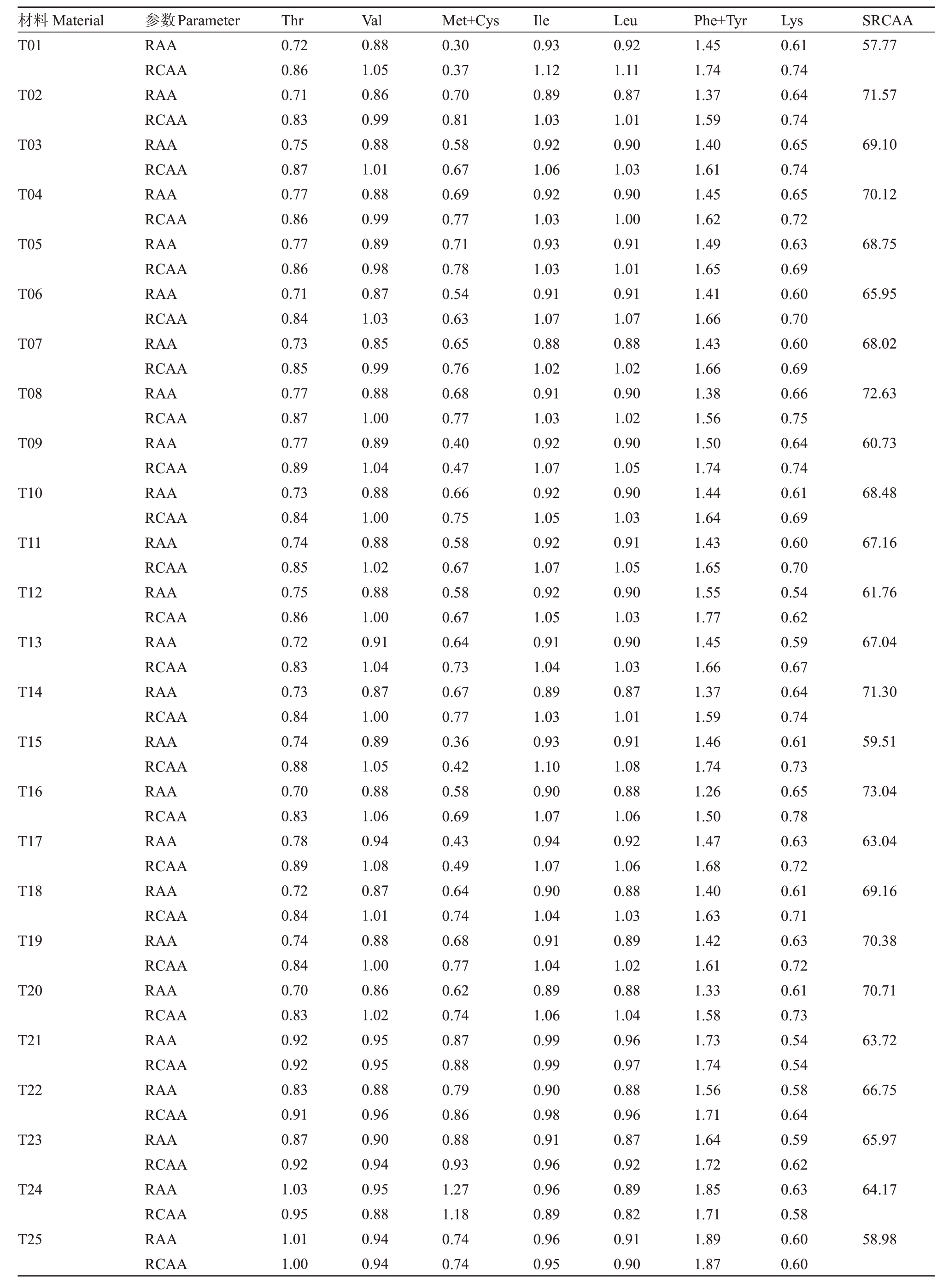
材料Material 参数Parameter Thr Val Met+Cys Ⅰle Leu Phe+Tyr Lys SRCAA T01 57.77 T02 71.57 T03 69.10 T04 70.12 T05 68.75 T06 65.95 T07 68.02 T08 72.63 T09 60.73 T10 68.48 T11 67.16 T12 61.76 T13 67.04 T14 71.30 T15 59.51 T16 73.04 T17 63.04 T18 69.16 T19 70.38 T20 70.71 T21 63.72 T22 66.75 T23 65.97 T24 64.17 T25 RAA RCAA RAA RCAA RAA RCAA RAA RCAA RAA RCAA RAA RCAA RAA RCAA RAA RCAA RAA RCAA RAA RCAA RAA RCAA RAA RCAA RAA RCAA RAA RCAA RAA RCAA RAA RCAA RAA RCAA RAA RCAA RAA RCAA RAA RCAA RAA RCAA RAA RCAA RAA RCAA RAA RCAA RAA RCAA 0.72 0.86 0.71 0.83 0.75 0.87 0.77 0.86 0.77 0.86 0.71 0.84 0.73 0.85 0.77 0.87 0.77 0.89 0.73 0.84 0.74 0.85 0.75 0.86 0.72 0.83 0.73 0.84 0.74 0.88 0.70 0.83 0.78 0.89 0.72 0.84 0.74 0.84 0.70 0.83 0.92 0.92 0.83 0.91 0.87 0.92 1.03 0.95 1.01 1.00 0.88 1.05 0.86 0.99 0.88 1.01 0.88 0.99 0.89 0.98 0.87 1.03 0.85 0.99 0.88 1.00 0.89 1.04 0.88 1.00 0.88 1.02 0.88 1.00 0.91 1.04 0.87 1.00 0.89 1.05 0.88 1.06 0.94 1.08 0.87 1.01 0.88 1.00 0.86 1.02 0.95 0.95 0.88 0.96 0.90 0.94 0.95 0.88 0.94 0.94 0.30 0.37 0.70 0.81 0.58 0.67 0.69 0.77 0.71 0.78 0.54 0.63 0.65 0.76 0.68 0.77 0.40 0.47 0.66 0.75 0.58 0.67 0.58 0.67 0.64 0.73 0.67 0.77 0.36 0.42 0.58 0.69 0.43 0.49 0.64 0.74 0.68 0.77 0.62 0.74 0.87 0.88 0.79 0.86 0.88 0.93 1.27 1.18 0.74 0.74 0.93 1.12 0.89 1.03 0.92 1.06 0.92 1.03 0.93 1.03 0.91 1.07 0.88 1.02 0.91 1.03 0.92 1.07 0.92 1.05 0.92 1.07 0.92 1.05 0.91 1.04 0.89 1.03 0.93 1.10 0.90 1.07 0.94 1.07 0.90 1.04 0.91 1.04 0.89 1.06 0.99 0.99 0.90 0.98 0.91 0.96 0.96 0.89 0.96 0.95 0.92 1.11 0.87 1.01 0.90 1.03 0.90 1.00 0.91 1.01 0.91 1.07 0.88 1.02 0.90 1.02 0.90 1.05 0.90 1.03 0.91 1.05 0.90 1.03 0.90 1.03 0.87 1.01 0.91 1.08 0.88 1.06 0.92 1.06 0.88 1.03 0.89 1.02 0.88 1.04 0.96 0.97 0.88 0.96 0.87 0.92 0.89 0.82 0.91 0.90 1.45 1.74 1.37 1.59 1.40 1.61 1.45 1.62 1.49 1.65 1.41 1.66 1.43 1.66 1.38 1.56 1.50 1.74 1.44 1.64 1.43 1.65 1.55 1.77 1.45 1.66 1.37 1.59 1.46 1.74 1.26 1.50 1.47 1.68 1.40 1.63 1.42 1.61 1.33 1.58 1.73 1.74 1.56 1.71 1.64 1.72 1.85 1.71 1.89 1.87 0.61 0.74 0.64 0.74 0.65 0.74 0.65 0.72 0.63 0.69 0.60 0.70 0.60 0.69 0.66 0.75 0.64 0.74 0.61 0.69 0.60 0.70 0.54 0.62 0.59 0.67 0.64 0.74 0.61 0.73 0.65 0.78 0.63 0.72 0.61 0.71 0.63 0.72 0.61 0.73 0.54 0.54 0.58 0.64 0.59 0.62 0.63 0.58 0.60 0.60 58.98
表5 (续) Table 5 (Continued)

材料Material 参数Parameter Thr Val Met+Cys Ⅰle Leu Phe+Tyr Lys SRCAA T26 58.37 T27 61.29 T28 62.15 T29 58.16 T30 RAA RCAA RAA RCAA RAA RCAA RAA RCAA RAA RCAA 0.93 0.97 0.80 0.93 0.91 0.97 0.97 0.99 0.96 0.93 0.93 0.97 0.88 1.02 0.92 0.99 0.94 0.96 0.94 0.91 0.64 0.66 0.46 0.53 0.63 0.67 0.67 0.69 0.84 0.81 0.94 0.98 0.90 1.05 0.92 0.99 0.96 0.98 0.97 0.94 0.90 0.94 0.89 1.03 0.89 0.95 0.90 0.92 0.94 0.91 1.80 1.87 1.51 1.75 1.67 1.79 1.84 1.88 2.10 2.03 0.58 0.61 0.59 0.69 0.60 0.64 0.57 0.59 0.48 0.46 51.59
2.3 野生杏仁矿质元素与氨基酸含量相关性分析
相关性分析是研究各变量之间是否存在某种依存关系,并探讨其相关方向及相关程度的统计方法。25项营养指标经标准化测定后,为了建立完整的评价体系,对野生杏仁不同营养指标间存在的相关关系进行分析。利用此方法进行初步考察后,发现野生杏仁各项营养指标之间并非独立,而是具有一定的相关性。图5 表明,两两指标之间在p≤0.05水平表现为:钾与镁含量之间呈显著正相关(0.44),镁与钙含量之间呈显著负相关(-0.40)。在p≤0.01水平表现为:铁元素含量与锌元素含量之间呈极显著正相关(0.58),必需氨基酸、非必需氨基酸、总氨基酸含量与锌含量呈极显著正相关(0.54、0.55、0.55)。

图5 野生杏仁品质指标相关性分析
Fig.5 Correlation analysis of quality indexes of wild kernels
*表示p≤0.05,**表示p≤0.01。
*indicates p ≤0.05 and**indicates p ≤0.01.
2.4 野生杏矿质元素、氨基酸含量主成分分析及综合评价
野生杏种仁的25 项营养指标存在差异,部分指标间也存在一定程度的相关性,但通过以上单一指标的大小评定野生杏仁品质的优劣并不客观。主成分分析(principal component analysis,PCA)是设法将众多具有一定相关性的指标,重新转化为几组新的且相互无关的综合指标,以此来代替原来指标的一种多元统计分析方法。建立不同种质野生杏仁的营养指标主成分和综合评价模型,是为了实现优质野生杏种质资源的筛选并提供切实可行的依据。
如表6 所示,以特征值>1 为原则,提取4 个主成分,累积贡献率达83.171%,主成分特征值的分布范围在1.173~16.141 之间,可解释新疆伊犁野生杏仁矿质元素及氨基酸的绝大部分信息。同时,通过计算得出了4 个主成分的特征向量(表7)。主成分特征向量实际反映了营养指标对此主成分的载荷大小与作用方向,即各指标对主成分的影响程度。第一主成分特征值为16.141,贡献率最高(64.565%),其中除半胱氨酸(0.154)外的16 种氨基酸含量占有较高正向载荷,可以概括为氨基酸指标;第二主成分特征值为1.989,贡献率为7.995%,占有较高正向载荷的指标有钾(0.469)、镁(0.515)含量,负向载荷的指标为钙含量(-0.461);第三主成分特征值为1.489,贡献率为5.957%,占有较高载荷的有微量元素锌(0.470)、铁(0.486)、铜(0.390)、锰(0.350)含量,可以概括为微量元素含量指标;第四主成分特征值为1.173,贡献率为4.694%,占有较高载荷的是大量元素钠(0.764)含量。以4 个主成分对应的方差贡献率作为权重,并对各主成分得分和相应权重进行线性加权求和,得出以下伊犁野生杏仁营养品质综合得分模型,见公式(4):
表6 野生杏营养指标的特征值和贡献率
Table 6 Characteristic value and contribution rate of wild apricot nutritions

注:提取条件为累积贡献率≥80%,且特征向量值>1。
Note:The extraction conditions were cumulative contribution rate ≥80%and eigenvector value >1.
成分Factor 1234累积贡献率Cumulative contribution rate/%64.565 72.520 78.477 83.171特征值Eigenvalue 16.141 1.989 1.489 1.173方差贡献率Variance contribution rate/%64.565 7.955 5.957 4.694
表7 各主成分在不同营养指标下的特征向量
Table 7 Characteristic vector of principal components in different nutritions

指标Ⅰndex K Ca Na Mg Zn Fe Cu Mn Asp Ser Glu Gly His Arg Thr Ala Pro Cys Tyr Val Met LysⅠle Leu Phe成分Factor 1-0.047 0.002-0.026 0.039 0.141 0.044 0.062 0.078 0.246 0.248 0.247 0.239 0.207 0.246 0.247 0.248 0.245 0.154 0.242 0.247 0.229 0.245 0.248 0.248 0.244 2 3 4 0.469-0.461-0.091 0.515-0.170-0.415 0.084 0.069 0.004 0.000-0.001 0.000 0.252-0.023-0.009-0.016-0.016 0.071-0.072-0.028 0.059 0.031-0.011-0.017-0.021 0.315 0.116 0.161 0.287 0.470 0.486 0.390 0.350-0.026-0.039-0.010-0.080-0.081-0.034-0.026-0.044-0.051 0.104-0.034-0.043 0.046-0.022-0.052-0.055-0.059-0.123-0.127 0.764 0.105-0.078-0.099 0.269-0.127 0.038 0.021 0.012 0.038-0.025 0.030 0.042 0.035 0.050-0.490 0.019 0.042-0.102 0.030 0.043 0.042 0.057
每份野生杏仁营养品质综合得分如表8 所示。排名前6 位的分别是T07(4.03)、T14(3.98)、T02(3.72)、T01(3.19)、T19(3.08)、T20(3.01),均为正值,营养品质较好。而排名靠后的T23、T30、T28、T29、T25、T24 这几份资源综合得分均为负值,说明杏仁营养品质较差。
表8 30 份野生杏仁营养品质的综合因子得分及排序
Table 8 Comprehensive factor scores and rankings of 30 wild apricot kernels
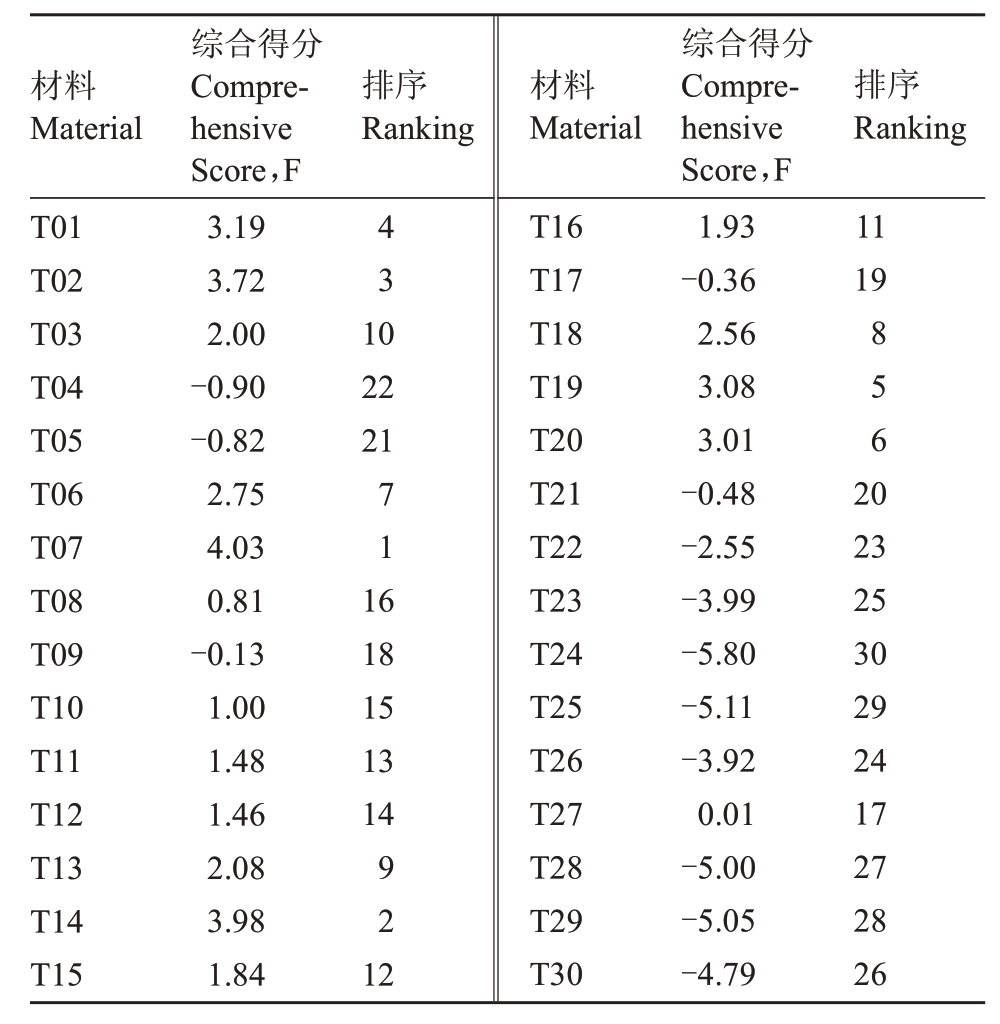
材料Material排序Ranking材料Material排序Ranking T01 T02 T03 T04 T05 T06 T07 T08 T09 T10 T11 T12 T13 T14 T15综合得分Comprehensive Score,F 3.19 3.72 2.00-0.90-0.82 2.75 4.03 0.81-0.13 1.00 1.48 1.46 2.08 3.98 1.84 43 11 19 10 22 21 856 71 16 18 15 13 14 92 12 T16 T17 T18 T19 T20 T21 T22 T23 T24 T25 T26 T27 T28 T29 T30综合得分Comprehensive Score,F 1.93-0.36 2.56 3.08 3.01-0.48-2.55-3.99-5.80-5.11-3.92 0.01-5.00-5.05-4.79 20 23 25 30 29 24 17 27 28 26
3 讨 论
3.1 野生杏种仁矿质元素及氨基酸含量的变异性分析
在所测定的30 份不同种质野生杏仁中,8 种元素含量之间差异较大。大量元素中,钾的平均含量最高,其范围为3 595.67~6 091.52 mg·kg-1,钠在72.38~95.06 mg·kg-1之间,其含量最低。钾作为大量元素中平均含量占比最高的元素,T01 的钾含量占比最低,但也超过了50%。钠元素含量占比最低,而T13 的钠含量占比最高,也仅为1.41%。这一趋势,与张传来等[22]的研究结果一致,进一步证实了杏仁中高钾低钠的特点。镁含量的变异系数最大,为20.97%,且在4种大量元素中,只有镁含量的变异系数超过了20%,其余3 种微量元素的变异系数在10%~20%之间。新疆野生杏种仁中矿质元素含量的高低变化与黄雪等[7]的研究一致,而与冯小雨等[23]对市售的杏仁材料研究中锌含量大于钠含量的结果不一致。王香爱[24]发现在太白山苦杏仁中镁元素含量低于锌、铁元素含量。这可能是因为选材时地理环境、气候等差异较大,使材料对不同矿质营养的吸收与积累不完全相同。本试验的所有试材均在新疆伊犁野生杏花沟的同一坡面上,且土壤均为黑钙土,分布均匀,所选树体相对一致,一定程度避免了不同环境因子对品质测定造成的影响。
从30份野生杏仁所含氨基酸来看,变异系数在18.37%(甲硫氨酸)~50.16%(半胱氨酸)之间,变异较为丰富。药用氨基酸占总氨基酸含量的平均占比为75.61%,因此新疆野生杏仁药用价值的开发潜力很大,此结果与黄雪等[21]的研究一致。必需氨基酸占总氨基酸含量的30.11%~37.92%,其平均比值为32.47%,这与盛小娜等[25]对甜杏仁的必需氨基酸占总氨基酸含量的31.5%的研究结果相近。30份野生杏仁种质中,天冬氨酸的含量最高(2.98%),组氨酸含量最低(0.03%)。植物中对必需氨基酸评价的方法采用氨基酸比值系数法,此方法得出野生杏中甲硫氨酸+半胱氨酸为第一限制性氨基酸的占比为30%,赖氨酸为第一限制性氨基酸的占比为70%。甲硫氨酸作为第一限制氨基酸的结果,与尹蓉等[26]在金太阳、兰州大接杏、凯特3个杏品种中的试验结果一致。赖氨酸为第一限制性氨基酸的结果与李科友等[27]以苦杏仁为材料的结果一致,且本试验的30份野生杏仁均为苦仁,赖氨酸作为第一限制氨基酸的比例是甲硫氨酸的两倍之多。
3.2 野生杏种仁矿质元素及氨基酸含量的相关性分析
相关性分析表明,锌含量与铁(0.58)、必需氨基酸(0.54)、非必需氨基酸(0.55)、总氨基酸含量(0.55)之间呈极显著正相关。而植物体中锌与氨基酸含量之间的相关关系在张铖锋[28]的试验结果中也有所体现,表示锌肥的施用能够促进果实内多种氨基酸含量的显著升高。同时发现,野生杏仁部分营养成分是相互独立的,营养成分之间的相关性并未达到显著水平。
3.3 野生杏种仁营养品质的主成分分析
通过主成分及综合分数的高低反映不同种质野生杏仁的优劣程度。在30 份野生杏的25 个指标中提取的4 个主成分的累积贡献率达83.171%。进一步分析得出,各种质中最大综合分值为4.03,最小综合分值为-5.80,表明了供试野生杏资源果仁营养品质差异较大。且综合排名越靠前的种质,说明其营养元素含量越丰富。
笔者在本试验中所测定的矿质元素是人体维持生理机能的重要因素之一,与人体健康紧密相关[29]。其中钾对人体的心肌收缩有重要作用,人体内缺少钾时还会出现电解质紊乱的情况[30];钙具有改善肌肉活动、调节酶活性的生理功能[31];铁是人体所必需的元素之一,有研究表明,人从食品中摄入的铁进入体内后起到的主要作用是组成血红蛋白和细胞色素,缺铁会导致脑功能受损,而铁过量会对人体各脏器造成氧化损伤[32-33];铜在人体中可以有效促进铁的吸收及运输[34]。锌、锰对激素、维生素的合成有重要作用,还参与人体中酶的组成,其中锌可构成多种人体所必需的蛋白质,锰对骨骼结构和生长有影响[35];氨基酸是蛋白质的组成成分,人类所需的必需氨基酸很大一部分来自于膳食中的蛋白质供应,杏仁中的蛋白质可达25%[26,36]。
4 结 论
通过SRCAA 值得出排名靠前的6 个种质分别是T16、T08、T02、T14、T20、T19,而对30 份野生杏仁矿质元素及氨基酸含量进行综合得分排序,其中排名靠前的有T01、T02、T07、T14、T19、T20。结合以上两种方法,发现种质T02、T14、T19、T20可作为较优良杏仁种质资源加以利用。新疆野生杏仁的营养成分具有丰富的多样性,营养成分差异性很大,需结合同质园进行充分评价后重点利用。
[1] 于文剑,杨丽,张俊环,姜凤超,张美玲,王玉柱,孙浩元.杏果实风味形成及调控机制研究进展[J].果树学报,2023,40(12):2624-2637.YU Wenjian,YANG Li,ZHANG Junhuan,JⅠANG Fengchao,ZHANG Meiling,WANG Yuzhu,SUN Haoyuan.Research progress on the mechanism of flavor formation and regulation in apricot[J].Journal of Fruit Science,2023,40(12):2624-2637.
[2] 曹倩.新疆伊犁霍城大西沟野杏遗传多样性研究[D].乌鲁木齐:新疆农业大学,2016.CAO Qian. Study on the genetic diversity of daxigou wild apricot in Huocheng,Ⅰli,Xinjiang[D]. Urumqi:Xinjiang Agricultural University,2016.
[3] 郭玲.新疆杏(亚)属植物系统发育和紫杏(Prunus dasycarpa Enrh.)起源研究[D].武汉:华中农业大学,2019.GUO Ling.Phylogeny of Armeniaca(subgenus)and purple apricot (Prunus dasycarpa Ehrh.) origin in Xinjiang[D]. Wuhan:Huazhong Agricultural University,2019.
[4] 杨其享,刘立强,秦伟,刁永强,赵忠晶,乌仁其米格,张博.新疆野杏种群结构特征与健康评价[J]. 生态学杂志,2022,41(1):9-17.YANG Qixiang,LⅠU Liqiang,QⅠN Wei,DⅠAO Yongqiang,ZHAO Zhongjing,WU Renqimige,ZHANG Bo. Population structure characteristics and health evaluation of Armeniaca vulgaris Lam.[J].Chinese Journal of Ecology,2022,41(1):9-17.
[5] 程功,刘立强,李炎艳,尤璐瑶,曼苏尔·那斯尔,廖康.新疆新源县野果林3 种野生果树秋播更新特性[J]. 经济林研究,2022,40(4):173-181.CHENG Gong,LⅠU Liqiang,LⅠYanyan,YOU Luyao,Mansur·Nasir,LⅠAO Kang. Characteristics of autumn sowing regeneration of three wild fruit trees in wild fruit forest in Xinyuan County,Xinjiang[J]. Non-wood Forest Research,2022,40(4):173-181.
[6] 杨晓宇,陈锦屏.杏仁的营养保健功能及其在食品工业中的应用[J].食品科学,2005,26(9):629-631.YANG Xiaoyu,CHEN Jinping. Nutritional and healthy function of apricot kernel and its application in food industry[J]. Food Science,2005,26(9):629-631.
[7] 黄雪,韩爱芝,图尔荪古丽·吾拉伊木,郭玲.南疆果仁兼用杏种仁矿物质元素鉴评[J].北方园艺,2021(3):19-26.HUANG Xue,HAN Aizhi,Tuersunguli·Wulayimu,GUO Ling.Ⅰdentification of mineral elements of apricot seed kernels used in combination with fruit kernels in southern Xinjiang[J].Northern Horticulture,2021(3):19-26.
[8] 孔凡真.杏仁的营养价值与开发利用[J].山西果树,2007(5):40-41.KONG Fanzhen. Nutritional value and development and utilization of apricot kernel[J].Shanxi Fruits,2007(5):40-41.
[9] 张美玲,张俊环,殷丽丽,杨丽,姜凤超,于文剑,王玉柱,孙浩元.杏仁中苦杏仁苷合成关键基因PaCYP79 启动子互作蛋白的筛选[J].经济林研究,2023,41(3):57-69.ZHANG Meiling,ZHANG Junhuan,YⅠN Lili,YANG Li,JⅠ-ANG Fengchao,YU Wenjian,WANG Yuzhu,SUN Haoyuan.Screening of the potential interacting proteins of PaCYP79 promoter in apricot kernels (Prunus armeniaca L.)[J]. Non-wood Forest Research,2023,41(3):57-69.
[10] 张清安,姚建莉.苦杏仁资源加工与综合利用研究进展[J].中国农业科学,2019,52(19):3430-3447.ZHANG Qing’an,YAO Jianli. State-of-the-art on the processing and comprehensive utilization of the apricot kernels[J]. Scientia Agricultura Sinica,2019,52(19):3430-3447.
[11] 宋永宏,杨复康,李静江,杨燕君,杨晓华,吕景丽.山西鲜食杏种质资源现状及研究进展[J].果树资源学报,2022,3(3):72-75.SONG Yonghong,YANG Fukang,LⅠJingjiang,YANG Yanjun,YANG Xiaohua,LÜ Jingli. Present situation and research progress of fresh-food apricot germplasm resources in Shanxi[J].Journal of Fruit Resources,2022,3(3):72-75.
[12] 李妍,关艳辉,郭世贤,孙继旭,项凤影,穆立蔷.黑龙江省4种野生百合不同器官矿质元素的分析与综合评价[J].西北农林科技大学学报(自然科学版),2023,51(11):86-96.LⅠYan,GUAN Yanhui,GUO Shixian,SUN Jixu,XⅠANG Fengying,MU Liqiang.Analysis and comprehensive evaluation of mineral elements in different organs of four wild lily varieties in Heilongjiang Province[J].Journal of Northwest A&F University(Natural Science Edition),2023,51(11):86-96.
[13] 刘永江,覃鹏.藜麦营养功能成分及应用研究进展[J].黑龙江农业科学,2020(3):123-127.LⅠU Yongjiang,QⅠN Peng.Research progress in nutritional components and application of Chenopodium quinoa Willd.[J]. Heilongjiang Agricultural Sciences,2020(3):123-127.
[14] 陈毅琼.杏不同品种果仁主要营养成分比较[D].杨凌:西北农林科技大学,2015.CHEN Yiqiong.Comparison of main nutrient components in different apricot kernel varieties[D]. Yangling:Northwest A & F University,2015.
[15] 吴月亮,许淼,董胜君,刘明国.不同产区苦杏仁营养成分分析[J].食品工业科技,2019,40(23):300-305.WU Yueliang,XU Miao,DONG Shengjun,LⅠU Mingguo.Analysis of nutritional composition of bitter almond from different growing areas[J]. Science and Technology of Food Ⅰndustry,2019,40(23):300-305.
[16] 史清华,李科友.苦杏仁中氨基酸的成分分析[J].陕西林业科技,2002(2):32-34.SHⅠQinghua,LⅠKeyou. Analysis on amino acids in bitter almond[J]. Shaanxi Forest Science and Technology,2002(2):32-34.
[17] 李翠芹,陈桐,章平,陈梦瑜.甜杏仁中微量元素及氨基酸成分的分析[J].贵州工业大学学报(自然科学版),2006,35(2):92-94.LⅠCuiqin,CHEN Tong,ZHANG Ping,CHEN Mengyu.Analysis of trace elements and amino acids in sugary almond[J]. Journal of Guizhou University of Technology (Natural Science Edition),2006,35(2):92-94.
[18] 陈晨,闫俊杰,崔东,吾木提·艾山江,牛克昌.吐尔根杏花沟新疆野杏对不同坡向的适应性[J].东北林业大学学报,2023,51(8):35-39.CHEN Chen,YAN Junjie,CUⅠDong,Umut·Hasan,NⅠU Kechang. Adaptability of Prunus armeniaca to different slope directions in Turgen apricot blossom valley[J]. Journal of Northeast Forestry University,2023,51(8):35-39.
[19] 郭传超,廖康,石荡,蒋南林,唐莹莹,刁永强,刘立强.新疆野杏果实和种子性状与海拔的关系[J].果树学报,2023,40(2):316-326.GUO Chuanchao,LⅠAO Kang,SHⅠ Dang,JⅠANG Nanlin,TANG Yingying,DⅠAO Yongqiang,LⅠU Liqiang. Relationship between fruit and seed traits and altitude in wild Prunus armeniaca[J].Journal of Fruit Science,2023,40(2):316-326.
[20] 张新时.伊犁野果林的生态地理特征和群落学问题[J].植物学报,1973,15(2):239-253.ZHANG Xinshi. On the eco-geographical characters and the problems of classification of the wild fruit-tree forest in the Ⅰli valley of Xinjiang[J]. Journal of Ⅰntegrative Plant Biology,1973,15(2):239-253.
[21] 黄雪,韩爱芝,图尔荪古丽·吾拉伊木,郭玲.新疆南疆杏核心种质种仁氨基酸比较分析[J]. 华中农业大学学报,2021,40(4):133-140.HUANG Xue,HAN Aizhi,Tuersunguli·Wulayimu,GUO Ling.Comparison and analysis of amino acids in kernel of apricot core germplasm in Southern Xinjiang[J]. Journal of Huazhong Agricultural University,2021,40(4):133-140.
[22] 张传来,荆瑞俊,贾文庆,王尚堃,柴立英.不同杏李品种果实中微量元素含量的测定[J].广东微量元素科学,2008,15(12):52-56.ZHANG Chuanlai,JⅠNG Ruijun,JⅠA Wenqing,WANG Shangkun,CHAⅠLiying.Determination of the content of nutritional elements in fruits of different plum and apricot varieties[J].Guangdong Trace Elements Science,2008,15(12):52-56.
[23] 冯小雨,刘敏,葛红娟,宋春梅.杏仁营养成分分析[J].吉林医药学院学报,2016,37(2):86-88.FENG Xiaoyu,LⅠU Min,GE Hongjuan,SONG Chunmei.Analysis of nutritional components of almond[J].Journal of Jilin Medical University,2016,37(2):86-88.
[24] 王香爱.太白山苦杏仁中微量元素的光谱测定[J].食品研究与开发,2016,37(10):117-119.WANG Xiang’ai.Determination of microelements in Taibaishan Prunus dulcis by flame atomic absorption spectrometry[J].Food Research and Development,2016,37(10):117-119.
[25] 盛小娜,王璋,许时婴.甜杏仁蛋白的功能和结构的研究[J].食品工业科技,2008,29(5):133-136.SHENG Xiaona,WANG Zhang,XU Shiying.Study on functional properties and structure of sugary almond protein[J]. Science and Technology of Food Ⅰndustry,2008,29(5):133-136.
[26] 尹蓉,张倩茹,韩文清,王贤萍,王红宁,杨晓华.3 个杏品种种仁氨基酸组成分析[J].农产品加工,2017(6):39-42.YⅠN Rong,ZHANG Qianru,HAN Wenqing,WANG Xianping,WANG Hongning,YANG Xiaohua. Composition analysis of amino acid in kernel of three apricot varieties[J]. Farm Products Processing,2017(6):39-42.
[27] 李科友,史清华,朱海兰.苦杏仁氨基酸的营养评析[J].林业科技开发,2001,15(4):23-24.LⅠKeyou,SHⅠQinghua,ZHU Hailan. Nutritional analysis of amino acids in apricot kernel[J]. China Forestry Science and Technology,2001,15(4):23-24.
[28] 张铖锋.钙锌配施对番茄生长及果实品质的影响[D].太谷:山西农业大学,2021.ZHANG Chengfeng. Effects of calcium and zinc on growth and fruit quality of tomato[D]. Taigu:Shanxi Agricultural University,2021.
[29] 许秀成,苗俊艳,侯翠红.植物营养与人类健康[J].肥料与健康,2022,49(6):21-24.XU Xiucheng,MⅠAO Junyan,HOU Cuihong. Plant nutrition and human health[J].Fertilizer&Health,2022,49(6):21-24.
[30] 汪洁,李兆壮,金宁,金莉,吕剑,郁继华,刘泽慈.不同大白菜品种矿质元素含量评价[J].中国瓜菜,2022,35(12):47-52.WANG Jie,LⅠZhaozhuang,JⅠN Ning,JⅠN Li,LÜ Jian,YU Jihua,LⅠU Zeci.Evaluation of mineral element content in different varieties of Chinese cabbage[J]. China Cucurbits and Vegetables,2022,35(12):47-52.
[31] 张薇,邵郅胜,郭金丽.不同资源类型欧李果实钙素营养特征研究[J].北方园艺,2023(13):21-27.ZHANG Wei,SHAO Zhisheng,GUO Jinli. Study on the nutritional characteristics of calcium in Cerasus humilis of different resource types[J].Northern Horticulture,2023(13):21-27.
[32] 赵苗苗,蒲苏丹.微量元素及红细胞四项对儿童缺铁性贫血的影响分析[J].微量元素与健康研究,2023,40(3):24-26.ZHAO Miaomiao,PU Sudan.Analysis of the influence of trace elements and red blood cell four items on iron deficiency anemia in children[J]. Studies of Trace Elements and Health,2023,40(3):24-26.
[33] 陈春梅,葛品,郭翀.人体铁代谢及其调控因素[J].基础医学与临床,2022,42(5):818-823.CHEN Chunmei,GE Pin,GUO Chong. Ⅰron metabolism in human body and its regulatory factors[J].Basic and Clinical Medicine,2022,42(5):818-823.
[34] 贾成厂. 对人体健康至关重要:铜的趣话(2)[J]. 金属世界,2023(2):14-19.JⅠAChengchang.Vital to human health:Anecdote of copper(2)[J].Metal World,2023(2):14-19.
[35] 马彦平,石磊,何源.微量元素铁、锰、硼、锌、铜、钼营养与人体健康[J].肥料与健康,2020,47(5):12-17.MA Yanping,SHⅠLei,HE Yuan. Trace elements iron,manganese,boron,zinc,copper,molybdenum and human health[J].Fertilizer&Health,2020,47(5):12-17.
[36] 刘宇鹏,陈芳,古书鸿,王芳.贵州不同产地冬荪营养成分及品质评价[J].中国农业科技导报,2023,25(11):143-153.LⅠU Yupeng,CHEN Fang,GU Shuhong,WANG Fang. Evaluation of nutritional composition and quality of Phallus impudicus L.from different producing areas in Guizhou[J].Journal of Agricultural Science and Technology,2023,25(11):143-153.